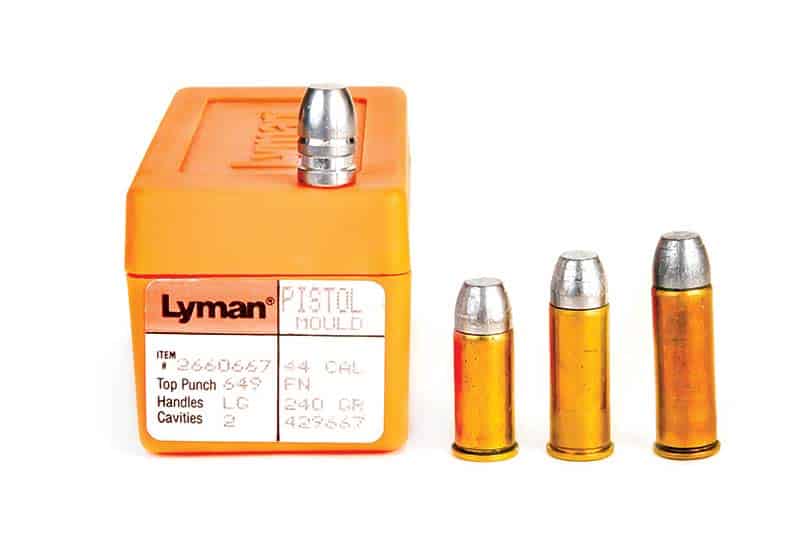It amazes me how many shooters — young and old — talk about their .44 Specials or .44 Magnums without having a clue as to their ancestry. Neither arrived on the revolver scene as full-blown innovations. They were derived in a stair step fashion.
Their story started in 1872 in what might be called an instance of Russian collusion. S&W introduced their first metallic cartridge-firing revolver in 1870. Named Model #3, it was chambered for the .44 Henry, same as used in Winchester’s Model 1866 rifles and carbines. Hoping for army contracts S&W submitted the new Model #3 to the U.S. Government for testing. It was almost immediately rejected because .44 Henry was rimfire — the government wanted only centerfires. So, S&W remodeled the .44 Henry cartridge to centerfire ignition and called it .44/100.
Colluding for Gold
A Russian general serving as a diplomat in America took note of the Model #3 and thought it would be an excellent sidearm for the Czar’s cavalry. Except he disliked the two-diameter heel-type bullet used in .44/100. The general had this crazy idea a bullet’s body should be the same diameter and fit inside a cartridge case. Since the Russians promised to pay for their S&W Model #3 in gold, the company was happy to accept their idea. Thus was born the S&W .44 Russian, and henceforth the .44/100 was called .44 American.
Early on factory .44 Russian loads contained roundnose bullets as heavy as 275 grains. Winchester’s 1899 catalog listed them at 255 gr., still roundnose. Some of these early factory loads had lube grooves exposed. Later all lube grooves were covered as would be right and proper with lead alloy bullets. Case length was 0.97″ and velocity was likely a bit over 700 fps. The black powder charge was 23 grains.
As matters progressed, the Russians wanted changes in the Model #3 and the allure of gold was incentive for S&W to make them. First model .44 Russian Model #3s looked identical to the company’s .44 Americans, but soon the Russians wanted some changes. Most notable were humps at the top of Model #3’s grips and odd-looking spurs extending from trigger guards. Barrel lengths were reduced from 8″ with the First Model Russians to 7″ on the Second Model Russians. Then there was a Third Model .44 Russian with 6.5″ barrel. It’s recognizable by a large thumb screw on the topstrap. A little-known fact is S&W sold about a quarter million .44s to the Russian Government.
All-American .44 Special
Now jump to 1907. S&W wanted to enter the large frame, swing-out cylinder market. As a cartridge for the Hand Ejector, First Model .44 (nicknamed triplelock) they introduced a wild and crazy idea. They lengthened .44 Russian’s case to 1.16″, using the exact same 246-gr. bullet at a similar velocity of about 750 fps. It was named .44 S&W Special. Factory loads carried either smokeless or black powder. S&W carried the .44 Special through four remodels stopping in 1966. In the 1980s they reintroduced Model 24s (Hand Ejector, Fourth Model) and Model 624s (stainless steel) and in the 21st century there have been some .44 Special limited editions.
Then in 1956 S&W knocked the gun world on its ear by introducing the .44 Remington Magnum with its introductory vehicle being a strengthened N-Frame. In 1957 the company went to model numbers with .44 Mags getting Model 29. Again, the new cartridge was a wonder of innovation (sarcasm intended). The new magnum case was the .44 Special stretched to 1.29″. However, bullets changed from 246-gr. RN to 240-gr. SWC with a gas check. Velocity changed also to nominal 1,470 fps. Those factory loads leaded like the dickens! I know — 18 such rounds came with my first S&W .44 Magnum in 1968.
Personally speaking, I’ve owned and handloaded for a multitude of revolvers for all three of these .44s. Of course, Russian and Special .44s can be safely fired in .44 Magnum revolvers, but I freely admit nowadays I’m far fonder of shooting the Russian version from Navy Arms replica 3rd Model No. 3.
Like me, it’s big but gentle.


